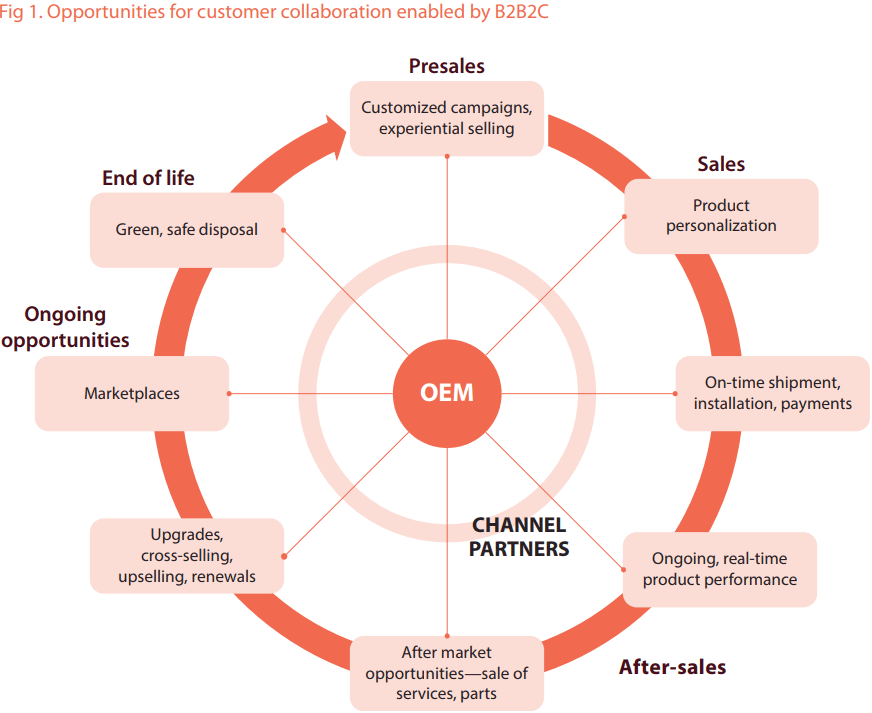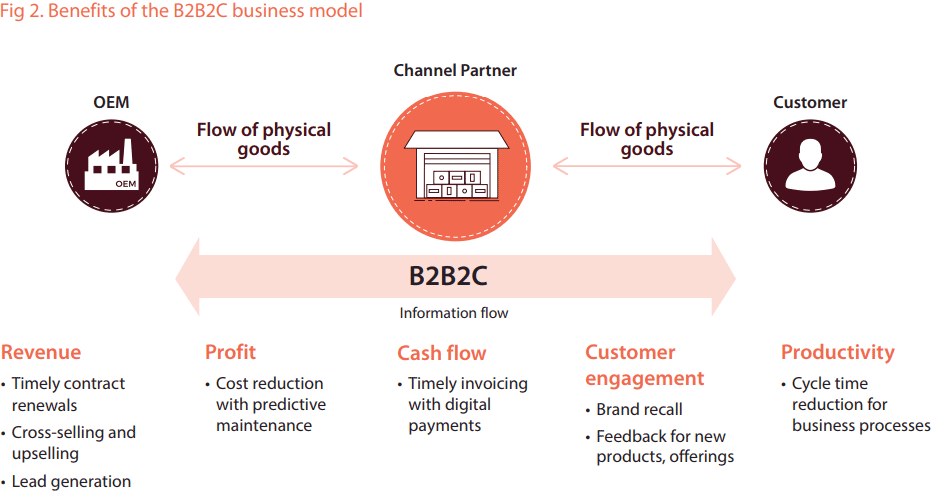For original equipment manufacturers (OEMs), the connection with end users does not stop at the point of sale. Technologies available today enable a mutually beneficial, profitable, and ongoing engagement with customers across the entire life cycle of products, with no change in the roles played by intermediary partners.
The blurring of lines — e-commerce, B2B or B2C
A common definition of e-commerce is “…the sale or purchase of goods or services, conducted over computer networks… .” Such trade is termed B2B when it takes place between enterprises and B2C when the consumer is involved.
According to a recent report published by UNCTAD (United Nations Conference on Trade and Development) in March 2019, global e-commerce surged to $29 trillion in 2017, with 13 percent annual growth.
In the United States, e-commerce-based trade was close to 40 percent of the gross domestic product, with more than 90 percent of it in the B2B space.
The proliferation of connectivity has blurred the lines between these terms. The scope of computer networks to conduct trade has extended beyond e-commerce and websites. The internet of things connects devices, exchanging not only product performance-related data but commercial information too, if required — placing an order for parts, for example. The internet and all its connected devices bring in the human element as well. This leads to a situation where any trade will have a digital thread, making these classifications irrelevant. B2B2C is an all-encompassing term for this trend where the product maker is in touch with the consumer at all points in time, and with commercial intermediaries in the ecosystem.
B2B2C for ongoing customer engagement
OEMs have traditionally had a B2B model, shipping their products to wholesalers, retailers, distributors or dealers, who in turn interfaced with customers. They can no longer rely only on a B2B approach, which stops with intermediaries and misses the crucial engagement with customers. At the same time, intermediaries cannot be removed from the supply chain. They have grown to understand the product and customers, and to offer last-mile services financially and for logistics from inquiry to order, installation, operation, service and repair.
The traditional B2B model is linear in nature and channel-driven, not customer-driven, with those inherent inefficiencies. Information and physical goods naturally flow from one entity to another. But such barriers are broken in a B2B2C setup. Information has fewer barriers to its flow when designed and implemented well, as shown in Figure 1. OEMs get a functional perspective aided by real-time information instead of a technical perspective on how their products are used in their intended fields of operation.
Volvo example
When Volvo* wanted to strengthen the connection with its customers, it decided to transform from a B2B to a B2B2C model without disrupting the relationship with its distribution network. Its network of dealers owned the sales and after-sales processes, along with the associated customer knowledge.
Starting with social media platforms and its own web presence, Volvo started a two-way conversation to build trust and loyalty rather than to increase sales or to compete with its distributors. Volvo’s connected car implementation provided a new way to stay in touch with customers and pass on this information to dealers. Timely reminders were sent to both customers and dealers, depending on the vehicle condition and availability of slots at the dealer’s repair shop. Some services were made available directly to customers.
Benefits of B2B2C
The impact that B2B2C can make on key business metrics is shown in Figure 2. There will not be significant changes in the physical flow of goods from the OEM to the customer unless it is targeted specifically. However, the flow of information will have a significant impact to improve key business metrics.
From a financial perspective, a B2B2C setup where assets are connected to the internet of things helps in timely renewal of contracts and minimizes revenue leakage. Awareness of asset condition along with the people connections helps in after-sales to sell accessories, upgrades, associated products and services.

B2B2C improves profitability with remote monitoring of products and timely action to avoid downtime.
Flow of information and cash is accelerated with digitized workflows, avoiding the need for human intervention.
Deep insights about individual customers help in customized marketing campaigns and brand creation and control. Once products are sold, insights personalize product configurations. Every point of customer connection, either virtual or physical, during a technician’s visit, is an opportunity to cross-sell and upsell. Safe and environmentally friendly disposal of a product at its end of life is a regulatory requirement and a business opportunity in itself.
In an engagement with a British telecom company, the Infosys Commerce practice implemented a unified customer experience with e-commerce and self-care across 16 countries. This resulted in a 20 percent improvement in customer advocacy and a 43 percent increase in online sales.
Traditional companies are migrating to this new model.

“We really see every B2B company and every B2C company becoming a B2B2C company.”

Approaches for transition to B2B2C model
The shift from a B2B to a B2B2C model can be achieved in stages, as explained below, starting with the people connection and extending it to include financial flow, product-related information flow and eventually a connected ecosystem that includes every player.
People connection – basic communication
For an organization that is used to a B2B way of working, the first step is to build a master database of its customer organizations — basic information for communication, likes, and dislikes. Outotec is a global provider of process solutions and technologies for the mining and metallurgical industries, with multiple business units across the production chain from minerals to metals.
When it realized the need to synergize the functioning of these units to maintain its leadership position, it partnered with Infosys for a CRM (customer relationship management) revamp. After a detailed assessment, they implemented a new model that accommodated each business unit’s diverse needs, culture, and locale. It equipped the sales team with tools, information, and interfaces for a faster sales cycle and lower cost of operations.
Financial flows – digitizing the order to-cash process
Following the people connection is the financial flow for two-way digital exchange of information and money. Digitization of the order-to-cash process is a broad example of financial flow. Vink VTS is a federation of more than 100 independent businesses that distributes plastics in Europe.
When its online operations became ineffective and expensive to operate, Vink VTS decided to standardize its e-commerce operations on one platform. The new platform had to be compatible with multiple industries, stores, and the complex price structures of each company. A central platform was rolled out and integrated with the ERP system. It provided visibility so customers could see their orders, price, deliveries, handling, and invoices online.
Product connection – performance monitoring and virtual experience
Technologies such as the internet of things enable a product connection. Product sensors collect vital performance information and feed it to the OEM. Virtual environments can be used to provide a feel of the product to customers without requiring their physical presence.
Aircraft makers have traditionally followed a B2B model, with airlines as their customers. As part of its digital transformation, Airbus did a what-if analysis to reach what was called 360-degree aerospace data. One integrated platform, named Skywise, was rolled out to consolidate flight-related information, from operations to maintenance. It started building a relationship with its passengers to provide content and a digital experience using augmented reality.
Ecosystem – new business models
When intermediaries play a key role in a transformed business model, the entire ecosystem gets involved. Tiremaker Michelin formed a separate division called Michelin Solutions in 2013 to leverage information systems for its new business models. EFFIFUEL™ was launched as an ecosystem-level fleet management program with contractual agreements to achieve fuel efficiency in truck usage. Michelin realized the importance of partnering with external experts in critical areas for successful digital transformation.
The internet of things was used for sensor-based tracking of vehicle and tire parameters. The telematics systems needed partners to install units and to manage the connections and data processing. The data was stored on the cloud and analyzed by Michelin’s experts to provide recommendations and training in eco-friendly driving. While Michelin directly engages fleet operators, its dealers and retailers help in order fulfillment and service.
The convergence of B2B and B2C
The lines between B2B and B2C business models are blurring into a converged B2B2C model. B2B2C will become the new norm to run a business. End customer engagement is an opportunity that businesses cannot afford to ignore or entrust to intermediaries. It will require a change not just in technology implementation but also in data usage, technology insights and a cultural transformation for direct customer engagement.
*Westerman, George; Bonnet, Didier; and McAfee, Andrew, “Leading Digital: Turning Technology Into Business Transformation,” Harvard Business Press, 2014





